Abstract
OBJECTIVE: To determine the relative risk of developing endometrial neoplasia after treatment with oestrogens alone or in conjunction with progestogens. DESIGN: Prospective cohort follow up study, average observation period 5.7 years for each patient. To have a 90% chance of detecting a relative risk of 2.0 with 95% significance the study required 78,000 person years of observation. SETTING: Community based cohort. PATIENTS: Women aged over 35 who were prescribed non-contraceptive oestrogens in the Uppsala health care region during April 1977 to March 1980 were identified from pharmacy records. Of all prescriptions issued, 95% were identified. Patients from the cohort who developed endometrial neoplasia were identified from the cancer registry of the Uppsala health care region. Compliance, sociodemographic data, and lifetime exposures to oestrogen and cyclically added progestogen were assessed by questionnaire in a sample of the cohort. The final cohort consisted of 23,244 patients (133,373 person years). The prevalence of university education, oophorectomy, and hysterectomy was higher in the cohort than the general population; no other confounding factors were identified. MEASUREMENTS: The total number of person years was divided into exposure groups by inference from the data from the questionnaire. Compensation was made for the excess of hysterectomies. Specimens from all cases of endometrial neoplasia in the cohort and 90% of cases in the general population were studied blind histopathologically. Characteristics of treatment of all women who had endometrial neoplasia were assessed by questionnaire. Relative risks and 95% confidence intervals were calculated. RESULTS: Seventy four cases of carcinoma and 33 cases of premalignant lesions occurred in the cohort. The relative risk of endometrial carcinoma was 1.8 (95% confidence interval 1.1 to 3.2) after exposure to any oestrogen compound without progestogen for more than six years; 2.2 (1.2 to 4.4) after more than three years' exposure to conjugated oestrogens without progestogen; and 2.7 (1.4 to 5.1) after more than three years' exposure to oestradiol compounds without progestogen. When carcinoma and premalignant lesions were considered together the results were similar but the relative risk was higher. Risk of carcinoma did not increase when progestogens were cyclically added to oestrogens for the entire treatment period (relative risk 0.9 (0.4 to 2.0]. CONCLUSIONS: Use of oestrogens without progestogens is associated with a twofold to threefold increase in risk of endometrial neoplasia. Use of progestogens either removes this increased risk or delays its onset. A further follow up of the cohort is essential to analyse the risks with greater statistical power.
Full text
PDF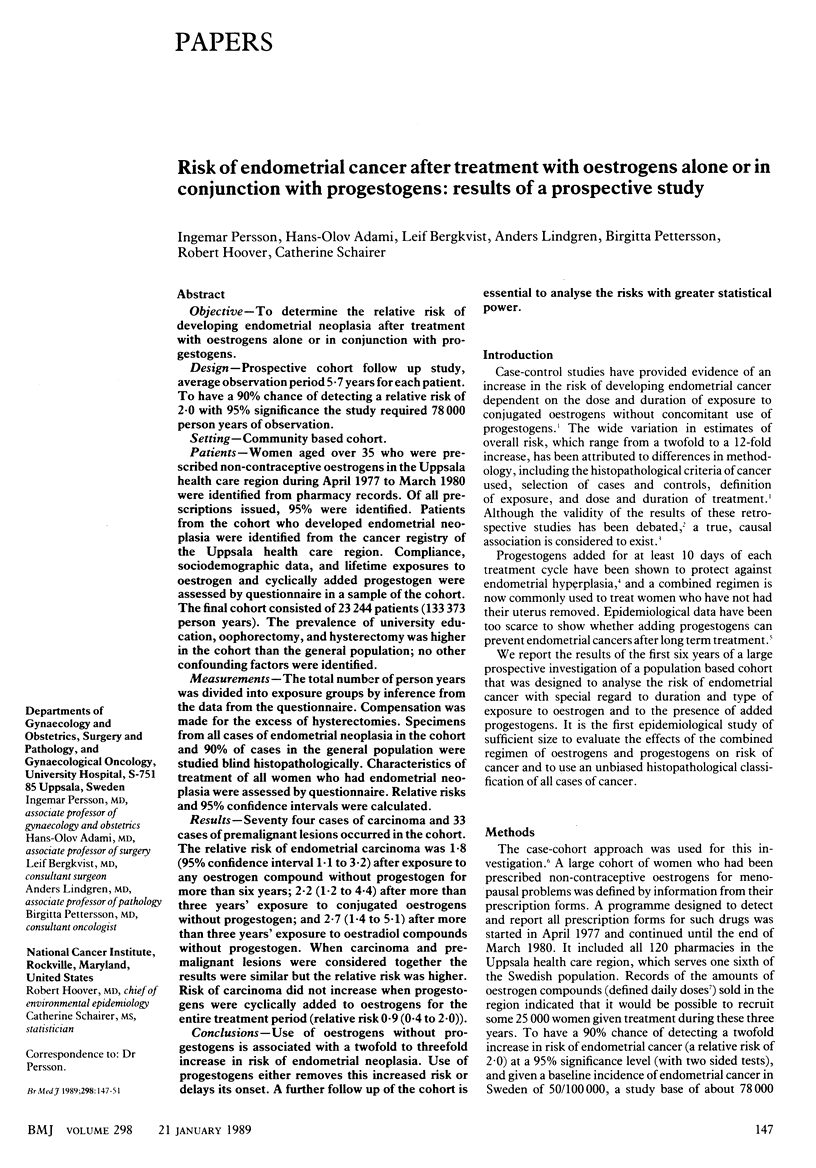
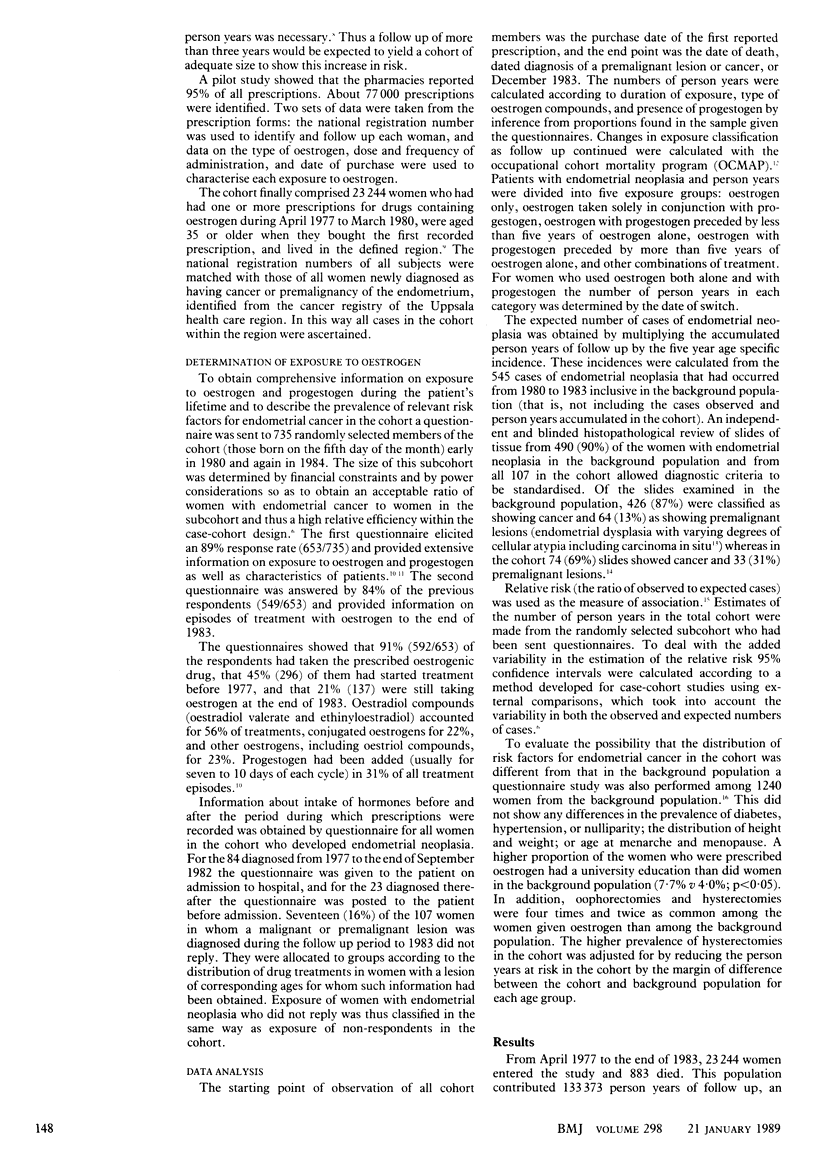
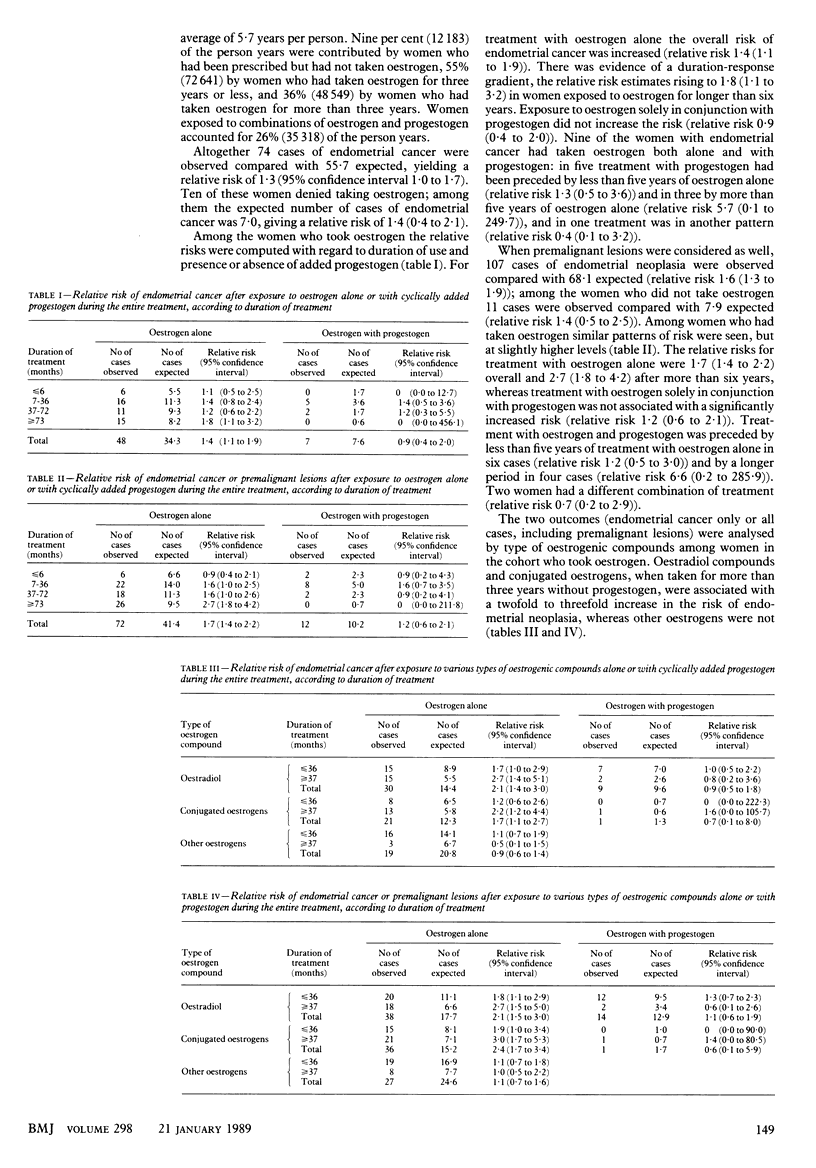
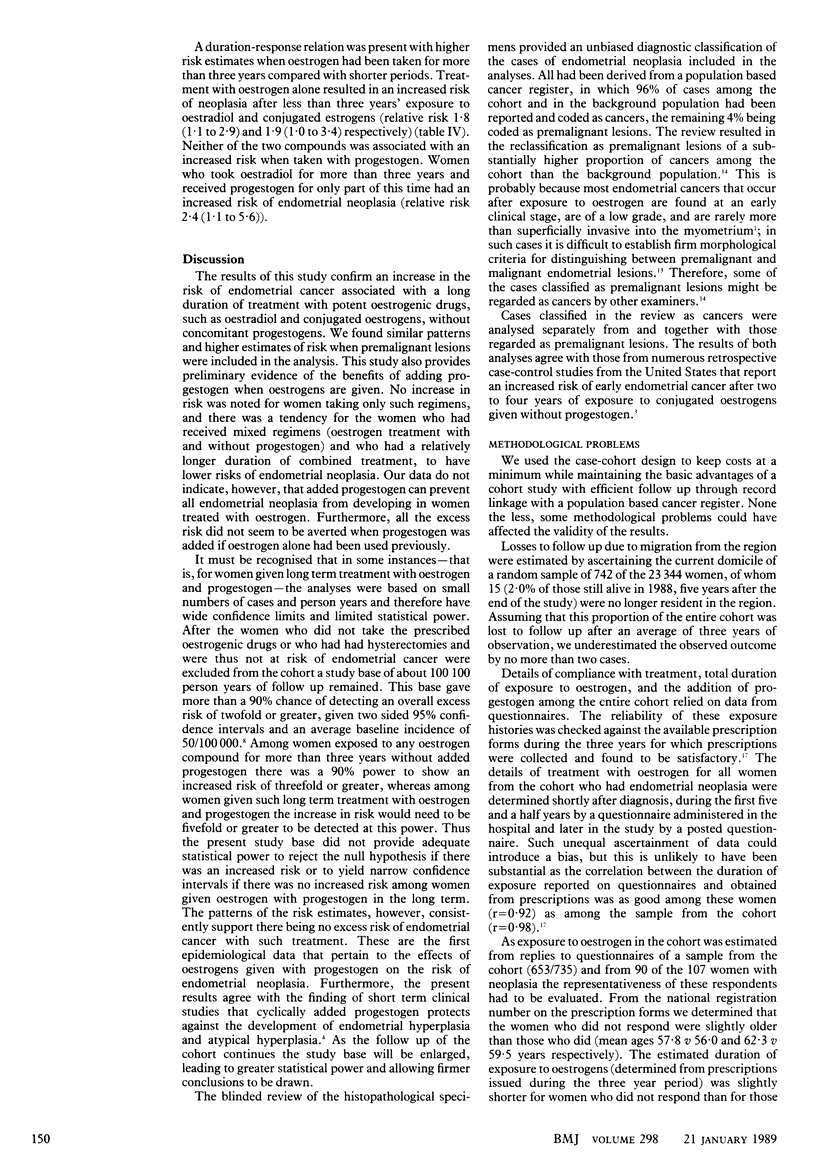
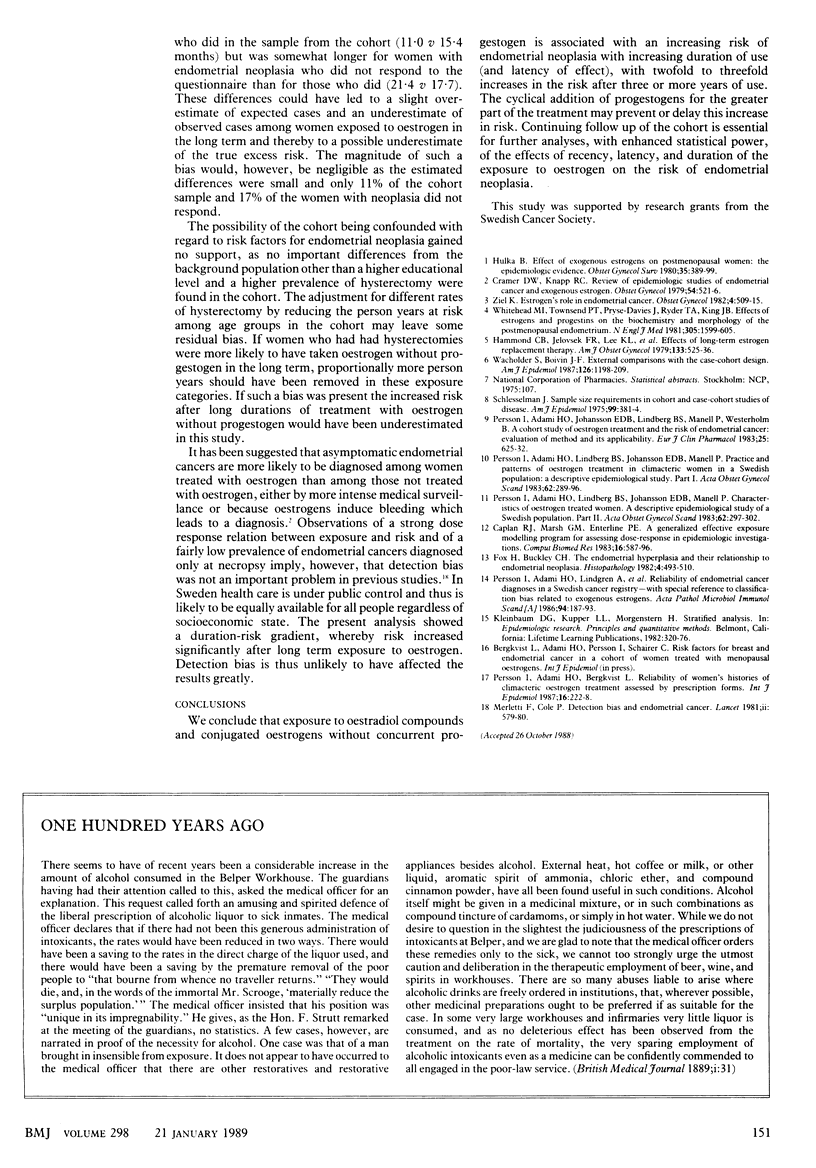
Selected References
These references are in PubMed. This may not be the complete list of references from this article.
- Caplan R. J., Marsh G. M., Enterline P. E. A generalized effective exposure modeling program for assessing dose-response in epidemiologic investigations. Comput Biomed Res. 1983 Dec;16(6):587–596. doi: 10.1016/0010-4809(83)90044-7. [DOI] [PubMed] [Google Scholar]
- Cramer D. W., Knapp R. C. Review of epidemiologic studies of endometrial cancer and exogenous estrogen. Obstet Gynecol. 1979 Oct;54(4):521–526. [PubMed] [Google Scholar]
- Fox H., Buckley C. H. The endometrial hyperplasias and their relationship to endometrial neoplasia. Histopathology. 1982 Sep;6(5):493–510. doi: 10.1111/j.1365-2559.1982.tb02747.x. [DOI] [PubMed] [Google Scholar]
- Hammond C. B., Jelovsek F. R., Lee K. L., Creasman W. T., Parker R. T. Effects of long-term estrogen replacement therapy. I. Metabolic effects. Am J Obstet Gynecol. 1979 Mar 1;133(5):525–536. doi: 10.1016/0002-9378(79)90288-6. [DOI] [PubMed] [Google Scholar]
- Merletti F., Cole P. Detection bias and endometrial cancer. Lancet. 1981 Sep 12;2(8246):579–580. doi: 10.1016/s0140-6736(81)90960-0. [DOI] [PubMed] [Google Scholar]
- Persson I., Adami H. O., Johansson E., Lindberg B., Manell P., Westerholm B. Cohort study of oestrogen treatment and the risk of endometrial cancer: evaluation of method and its applicability. Eur J Clin Pharmacol. 1983;25(5):625–632. doi: 10.1007/BF00542350. [DOI] [PubMed] [Google Scholar]
- Persson I., Adami H. O., Lindberg B. S., Johansson E. D., Manell P. Characteristics of estrogen-treated women. A descriptive epidemiological study of a Swedish population. Part II. Acta Obstet Gynecol Scand. 1983;62(4):297–302. doi: 10.3109/00016348309156225. [DOI] [PubMed] [Google Scholar]
- Persson I., Adami H. O., Lindberg B. S., Johansson E. D., Manell P. Practice and patterns of estrogen treatment in climacteric women in a Swedish population. A descriptive epidemiological study. Part I. Acta Obstet Gynecol Scand. 1983;62(4):289–296. doi: 10.3109/00016348309156224. [DOI] [PubMed] [Google Scholar]
- Persson I., Adami H. O., Lindgren A., Nordlinder H., Pettersson B., Silverberg S. Reliability of endometrial cancer diagnoses in a Swedish Cancer Registry--with special reference to classification bias related to exogenous estrogens. Acta Pathol Microbiol Immunol Scand A. 1986 May;94(3):187–194. doi: 10.1111/j.1699-0463.1986.tb02984.x. [DOI] [PubMed] [Google Scholar]
- Persson I., Bergkvist L., Adami H. O. Reliability of women's histories of climacteric oestrogen treatment assessed by prescription forms. Int J Epidemiol. 1987 Jun;16(2):222–228. doi: 10.1093/ije/16.2.222. [DOI] [PubMed] [Google Scholar]
- Wacholder S., Boivin J. F. External comparisons with the case-cohort design. Am J Epidemiol. 1987 Dec;126(6):1198–1209. doi: 10.1093/oxfordjournals.aje.a114759. [DOI] [PubMed] [Google Scholar]
- Whitehead M. I., Townsend P. T., Pryse-Davies J., Ryder T. A., King R. J. Effects of estrogens and progestins on the biochemistry and morphology of the postmenopausal endometrium. N Engl J Med. 1981 Dec 31;305(27):1599–1605. doi: 10.1056/NEJM198112313052701. [DOI] [PubMed] [Google Scholar]
- Ziel H. K. Estrogen's role in endometrial cancer. Obstet Gynecol. 1982 Oct;60(4):509–515. [PubMed] [Google Scholar]


